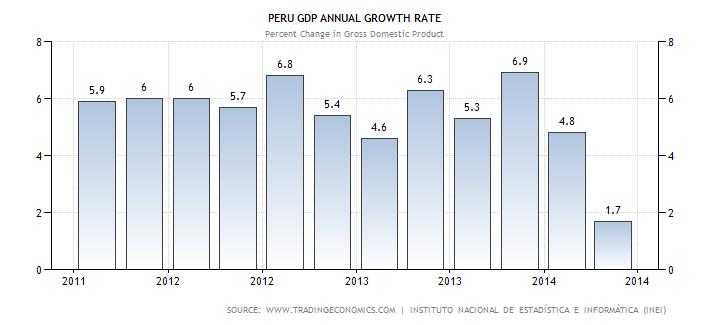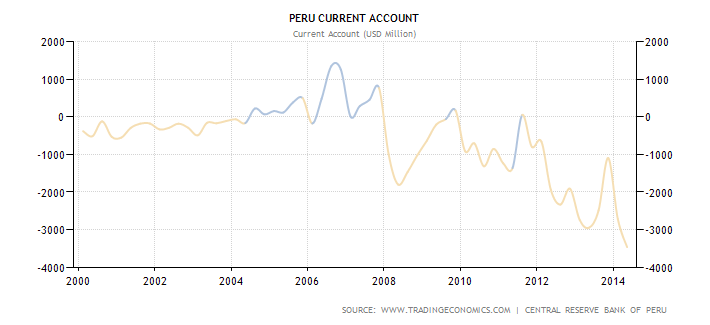Peru has had a tremendous economic run over the last few years. Will that growth continue as some predict, or will growth cool as the global economy also slows?
Peru’s growth for the 21st Century has been impressive, and it is currently ranked 55th in the world for economic growth. (source) They have also been the fastest growing economy in South America. However, with falling commodity prices & slowing exports what will the future bring?
Slowing Growth
As you can see, in 2014 growth has slowed considerably, although is still quite good. According to Bloomberg, third quarter growth in 2013 was the slowest since 2009 at 4.4%. (source) Since the first quarter of 2014, growth has been below 5%. In April, the central bank reduced its 2014 economic expansion forecast to 4.4 percent from 5.5 percent.
Growing Trade Deficit
Peru posted a $3.47 billion trade deficit for the third quarter, which has been increasing steadily. Lately, they have suffered in the Forex markets and the Central Bank has been selling dollars almost daily to slow the decline. At this writing the Peruvian sol has today fallen as low as S./2.935 to the US dollar – lowest in 5 years. (Note the increase in the trade deficit for 2012-2014.)
For a broader look & more information see also BBVA Latin American Outlook (PDF)
Environmental Reforms Invite Investors – Spark Protests
With the slowing of investment money inflows, and falling metals prices, on July 11 President Ollanta Humala unveiled a series of reforms intended to revitalize Peru’s economy, and entice investors by reducing environmental regulations. (Source)
Meanwhile, while reducing environmental standards, the government appears to want to be more involved in the transportation/communication/technology sectors.
According to an article in today’s Gestion,
———-
Growth over the next decade will be more elusive, says minister Gallardo Ku
From: Gestión Economy 17:50 Tuesday, November 4, 2014
Using Google translator (italics and parenthesis added for clarity)
The MTC (Minister of Transportation & Communications) said to boost growth in the next 10 years will require “more government.” He highlighted the work of government in education, health, production and infrastructure. In the Cabinet are convinced that the conditions for Peru have complicate (will be more complicated & grow) grow in the coming years.
According to the Minister of Transport and Communications, growth will be elusive in the next decade. ” Talking with Cabinet colleagues with Piero (Ghezzi) and Alonso (Segura,)we are quite convinced that the growth of the next decade will be more elusive,” said the minister. That is why we felt that in this new decade for Peru to be successful requires ” more government.”
During his participation in the XX V CIES Annual Seminar 2014, MTC highlighted the work of the Government in reforming education and health. In the first case seeking to upgrade the skills of workers and the second to reach places where the service is still not given. He noted that the issue has been working to diversify production, where the Minister of Production, Piero Ghezzi, is strongly pushing the issue of training through CITES (the centers of technological innovation.)
While Gallardo felt that the issue of infrastructure logistics infrastructure with a vision is developed, it is essential to telecommunications matters. ” If we do it we are not able to offer high-speed Internet in all regions of the country, and health education efforts and many productive diversification is not going to achieve,” he said.
———-
While government can be effective particularly with infrastructure projects, the endemic corruption in Peruvian politics makes them inefficient at best.
Debt vs GDP
For the last 10 years, Peru has been reducing its Debt vs GDP ratio, and is in an enviable position compared to many western nations. Hopefully, they will continue to be fiscally responsible if there are any additional slowdowns or commodity price drops.
Real Estate
Our observation is that there is currently a real estate bubble that is slowly losing steam (much like 2006-2007 in the US.) Prices are now flat, unlike 2012 where prices rose a blistering 30% in Lima.
What is quite different in Peru is that the median age is 27.5 years, which allowing for family expansion, and immigration (both from outside of the country & from country to city) could keep the real estate market in Lima strong for quite a while yet. As we move into 2015, we should begin to get a clearer picture of whether it is overbuilt or not. The Peruvian government has several programs which encourage home ownership via subsidies etc.
In the provinces, we are seeing cracks in land prices which usually foreshadow a general real estate slowdown. Foreclosures have increased as well as the number of delinquent loans.
What will the future bring?
As the global economy slows, and if commodity prices remain low, Peru will probably begin to see growth rates drop closer to the 1-2% range, particularly if we see more slowing in China.
Peru is a high interest rate environment, so there are considerable “tools” left for the Central Bank such as interest rate reductions. The low debt to GDP ratio could allow for further stimulus via government borrowing, and any big uptick in metals prices could reignite growth. If the current fall in the Peruvian Sol continues, it will have inflationary effects that may restrict the Central Bank from too much stimulus.
___
Did you enjoy this page? Have questions? Would like information on something to be posted here? Please drop us a line, sign up for our email list in the box to the right, or comment below.




